Once, an observer saw 136 crows mobbing a Great Horned Owl in Texas. This is called bird mobbing. It’s when smaller birds work together to defend against bigger predators like hawks and owls. They do this to protect their homes, nests, and young.
This behavior is driven by instinct. It shows how birds use teamwork to survive. By understanding this, we can learn more about how birds interact with each other.
Key Takeaways
- Mobbing is a common behavior where smaller birds collectively harass larger predators like hawks and owls to defend their territories and young.
- Common mobbers include chickadees, titmice, kingbirds, blackbirds, grackles, jays, and crows, while targets often include hawks, crows, ravens, herons, and owls.
- Mobbing is especially prevalent in the spring due to hormonal changes and nesting activities, but it can occur year-round.
- Mobbing usually does not harm the larger bird, but it serves as an effective deterrent and defense mechanism for the smaller birds.
- The behavior is driven by instinctual survival strategies and can involve cooperation between multiple species targeting a common threat.
Understanding the Phenomenon of Bird Mobbing
Birds have a clever way to defend themselves and their young called mobbing. This tactic involves a group of smaller birds, from different species, attacking a bigger bird of prey. They do this to scare away the threat and protect their homes and babies.
Definition and Basic Concepts
Mobbing is when birds work together to keep their territory safe from predators. Smaller birds like chickadees and titmice join forces to harass a larger bird of prey. Their goal is to make the predator feel unwelcome and leave the area.
When and Why Mobbing Occurs
Mobbing is most common during the breeding season. Birds are very protective of their nests and young during this time. They also mob to protect their food and territory from threats at other times of the year.
Common Participants in Mobbing Behavior
Many bird species mob, including crows, ravens, and even smaller birds like chickadees. They work together to chase away bigger predators like hawks and owls. This helps keep their territories safe.
“Mobbing calls may serve as warnings to other small birds, and may attract larger predators to pursue the target of the mobbing.”
Why Do Small Birds Chase Hawks?
Small birds like crows, jays, and songbirds chase hawks aggressively. They do this to protect their homes, nests, and young. This behavior is a natural instinct to keep their territory safe.
When it’s breeding season, small birds are extra careful. They chase hawks to keep them away from their nests and food spots. This is a key prey safety strategy to protect their families.
The way small birds mob hawks is amazing. They work together, even with different species, to scare away hawks. This teamwork helps keep their communities safe from predators.
| Behavior | Explanation |
|---|---|
| Mobbing | The aggressive chasing and harassing of larger predatory birds, like hawks, by smaller birds to protect their territories, nests, and offspring. |
| Alarm Calls | Loud calls made by small birds to alert other individuals, including those from different species, of the presence of a potential predator in the area. |
| Collaborative Efforts | Different species of small birds, such as crows and songbirds, working together to drive a common threat, like a hawk, out of an area. |
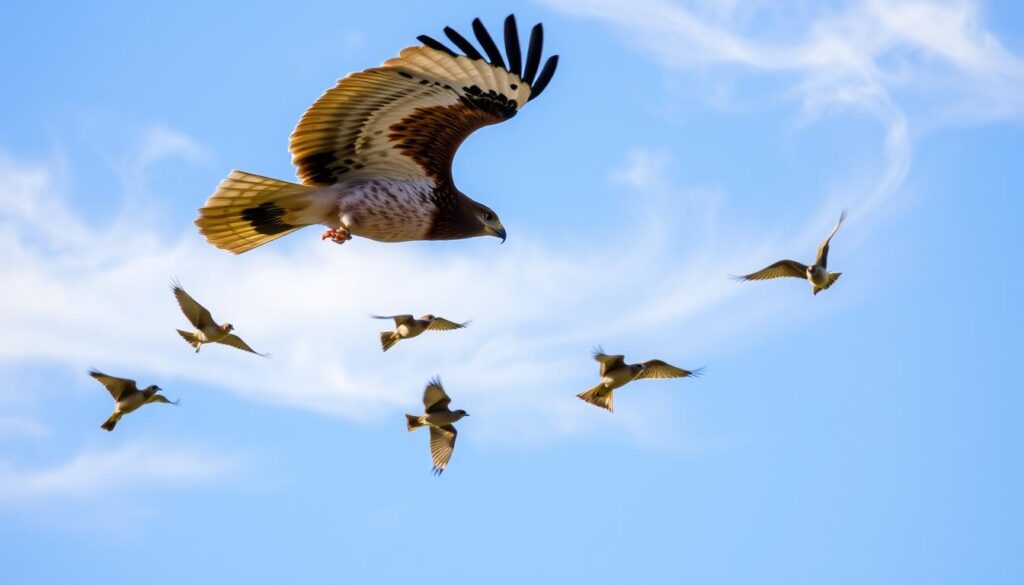
The surprise factor plays a big role in small birds’ mobbing. When a hawk is spotted, it often leaves the area. This makes the environment safer for the smaller birds and their young.
“The constant harassment by smaller birds can irritate and drive away raptors, causing them to potentially seek hunting opportunities in other areas.”
The Science Behind Avian Defensive Tactics
Small birds have evolved complex ways to defend themselves against larger predators like hawks. These avian defensive tactics are shaped by hormones, territorial instincts, and anti-predator adaptations.
Hormonal Influences on Mobbing Behavior
During breeding seasons, small birds become more aggressive towards predators. Hormones like testosterone and corticosterone boost their territorial defense and nest guarding. This makes them more protective of their young.
Territorial Defense Mechanisms
Birds fiercely defend their territories to safeguard their nests. Both males and females mark their areas and use displays to keep rivals away. This territorial defense can lead them to attack predators, including hawks and humans.
Survival Adaptations
The anti-predator adaptations of small birds help them mob larger predators. Their quickness, agility, and flock coordination make it hard for predators to catch them. This reduces the success rate of attacks.
“Mobbing behaviors by small birds create difficulty for predators to hunt effectively and serve as a call to arms for other birds in the vicinity.”
Common Bird Species Known for Mobbing
Mobbing is when smaller birds chase and harass larger birds. This behavior is seen in many species. They work together to protect their nests and young from threats.
Blue jays, crows, and mockingbirds are known for mobbing. They chase birds like red-tailed hawks in spring and early summer. People in Jersey City have shared stories of being mobbed by mockingbirds in parks.
Smaller songbirds like chickadees, titmice, and kingbirds also mob. They form groups to protect their nests and chicks. Mobbing is more common when there are eggs or young birds in the nest.
Crows can also be mobbed by smaller birds. They see crows as a threat to their nests. But crows also mob hawks and eagles to stay safe.
Mobbing is a key defense for birds, especially during breeding season. Smaller birds work together to keep predators away. This shows the complex social dynamics and survival instincts of birds.
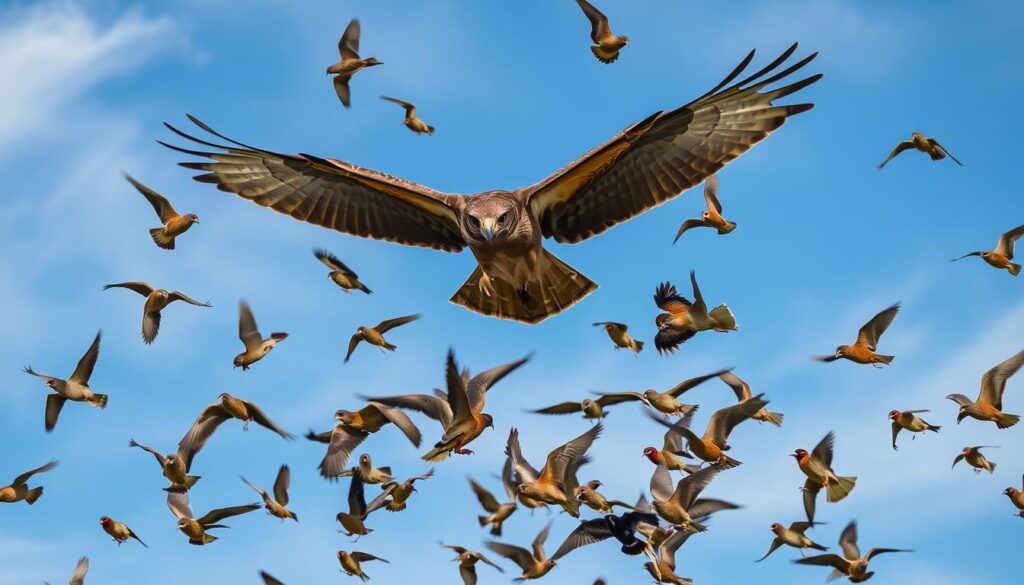
| Bird Species | Mobbing Behavior | Targeted Predators |
|---|---|---|
| Blue Jays | Aggressive chasing and dive-bombing | Red-tailed Hawks |
| Crows | Keeping a safe distance from active nests | Hawks, Eagles |
| Mockingbirds | Attacking and mobbing in urban parks | Raptors |
| Chickadees, Titmice, Kingbirds | Coordinated group efforts to drive away threats | Larger predatory birds |
Mobbing by smaller birds is a remarkable example of their adaptability. It shows how they work together to survive. By studying these behaviors, we can learn more about bird interactions and their survival strategies.
Seasonal Patterns in Mobbing Behavior
Bird behavior, especially “mobbing,” shows interesting seasonal patterns. In the spring, small birds aggressively chase and scare away larger birds like hawks. This is to protect their nests and young from threats.
Spring Breeding Season Peak
When spring comes, small birds become very territorial and watchful. They are ready to fight off any predators to protect their babies. This is why mobbing is at its highest during the breeding season.
Winter Mobbing Variations
Even though mobbing is most common in spring and summer, it happens all year. In winter, when food is hard to find, birds mob predators to defend their territory and food sources. But, winter mobbing is not as intense as in the breeding season.
The changing patterns of bird mobbing show how birds adapt to survive. By studying these patterns, we learn more about bird behavior and how birds interact with their environment.
How Mobbing Protects Bird Communities
Mobbing is a key defense strategy for birds. It helps them work together to keep predators away. This makes their community safer for everyone, especially their young.
Birds mob to protect their nests and babies during breeding season. They chase and dive-bomb predators like hawks and owls. This scares them off and keeps the babies safe.
Mobbing isn’t just for protecting young. It also helps birds defend food and distract predators. This way, they can safely get to their food sources.
The mobbing strategy shows how birds cooperate and communicate. Larger birds, like red-tailed hawks, are often mobbed by smaller ones. This not only keeps the flock safe but also warns other birds of danger.
“Mobbing plays a crucial role in predator identification and inter-generational learning about predators in bird communities.”
Learning about mobbing helps us understand bird social dynamics and survival strategies. It makes us appreciate nature more and helps us protect these ecosystems.
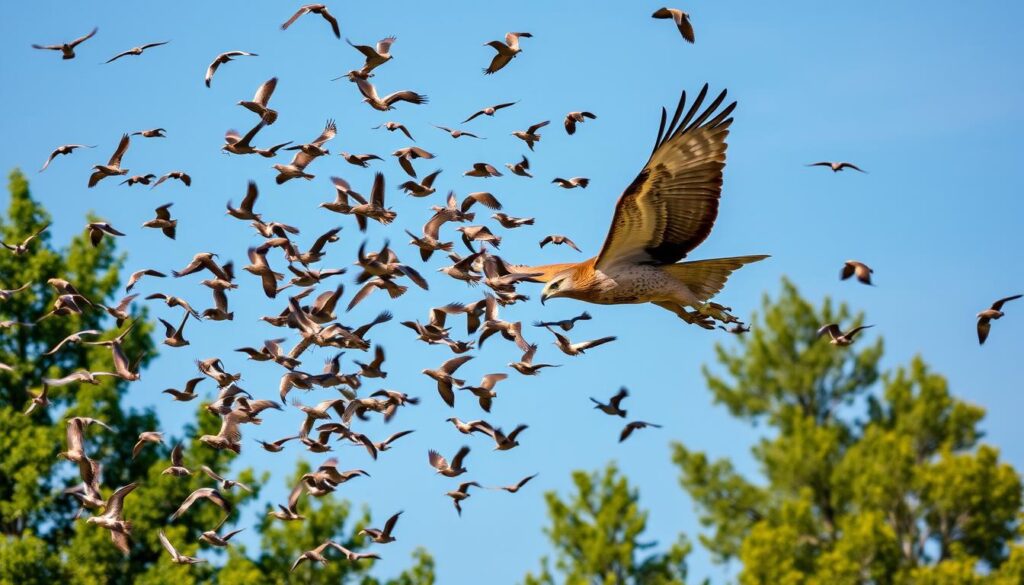
The Role of Communication in Mobbing
Communication is key in bird mobbing. Birds like blue jays and chickadees use alarm calls to warn others of predators. These avian communication methods help them work together to chase away threats.
When one bird calls out, it alerts others nearby. This inter-species cooperation is made easier because mobbing calls sound similar across different birds.
Alarm Calls and Warning Systems
Mobbing calls are different from regular birdsong. These sounds, like cawing or angry chirps, tell other birds to act. Research shows that some calls warn of hawks, while others warn of owls.
Inter-species Cooperation
When many bird species mob together, they have a better chance of scaring away a predator. Birds like cardinals and tit-mice join in, adding their own calls and actions to the defense.
https://www.youtube.com/watch?v=uSWcIbNlr9w
The ability of birds to communicate and work together during mobbing shows the complexity of avian communication. It’s crucial for their survival and protection.
Hawks as Targets: Types and Responses
Hawks, like the Red-tailed Hawk and Cooper’s Hawk, often face mobbing from small birds. These birds defend themselves against hawks, which can trigger a strong response. Hawks may leave or stay, depending on the situation.
The success of mobbing against hawks depends on the number of birds involved and their determination. Crows, for example, gang up on hawks during breeding season and chase them away. Songbirds like eastern kingbirds and red-winged blackbirds also defend their nests against hawks.
Other birds, such as Steller’s jays, blue jays, and chickadees, mob smaller owls. This behavior is crucial for defending their territories and nests. It keeps larger predators away.
| Hawk Species | Mobbing Behavior | Predatory Adaptations |
|---|---|---|
| Red-tailed Hawk | Frequent target of mobbing due to their size and hunting prowess | Excellent vision to spot prey hidden in the grass, known for pouncing on small mammals |
| Cooper’s Hawk | Targeted by songbirds and larger birds like crows during the breeding season | Short, rounded wings and long tails to navigate through forests and dense foliage while ambushing prey |
| Northern Harrier | Mobbed by a variety of bird species due to their hunting behavior | Long wings and tails to help them stay low and steady during flight while hunting over large fields and marshes |
The relationship between hawks and their mobbing counterparts is complex. It involves predator-prey dynamics, defense mechanisms, and adaptations. Knowing which hawks are targeted and how birds respond to them helps us understand avian interactions and the evolution of defense strategies.
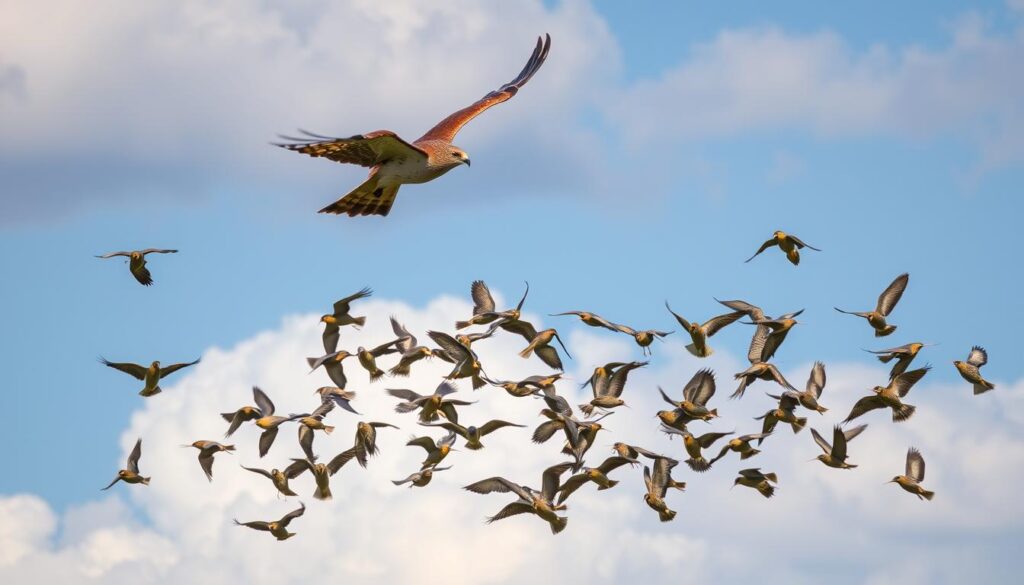
Impact of Mobbing on Predator Behavior
Mobbing by small birds is a powerful way to keep hawks away. These birds work together to scare off predators. This not only stops the hawk from hunting but also makes it leave the area.
Deterrence Effects
Research shows mobbing can really scare off predators. When birds like prothonotary warblers and blue-gray gnatcatchers attack a hawk, it often has to leave. This helps the birds by making it harder for the hawk to find food.
Territorial Displacement
The constant mobbing can make a predator leave its usual hunting spots. This is especially true for big birds like crows. They can chase away hawks and owls, forcing them to find new places to hunt.
Mobbing doesn’t hurt the big bird but makes it hard for it to hunt in the area. It shows how clever small birds are at keeping themselves safe from hawks and other predators.
“Mobbing behavior is described as the most frequently observed overt antipredator strategy.”
Safety Aspects of Mobbing Behavior
At first glance, prey safety strategies like mobbing in bird behavior seem risky. But, these tactics are often safer than they appear. The birds’ quick movements and lack of surprise make it harder for predators to attack.
Yet, there are mobbing risks to consider. Sometimes, birds may even touch the predator they’re chasing away.
Mobbing is a defense strategy where birds work together to scare off predators. This behavior has developed in many species to protect their young. By calling out, birds can gather more help to chase away the threat.
Different bird species often team up to mob predators. This is especially true during nesting season when young birds are more vulnerable. Male birds may also show off their bravery to attract female mates through mobbing.
“When multiple species of birds are heard squawking loudly in a small area, it indicates mobbing behavior towards a predator like a Hawk or Owl.”
Mobbing might seem dangerous, but it’s often safer than facing a predator alone. The birds’ quick movements and teamwork make it a strong defense. Still, there are times when birds may get too close to the predator, showing the risks of this bird behavior.
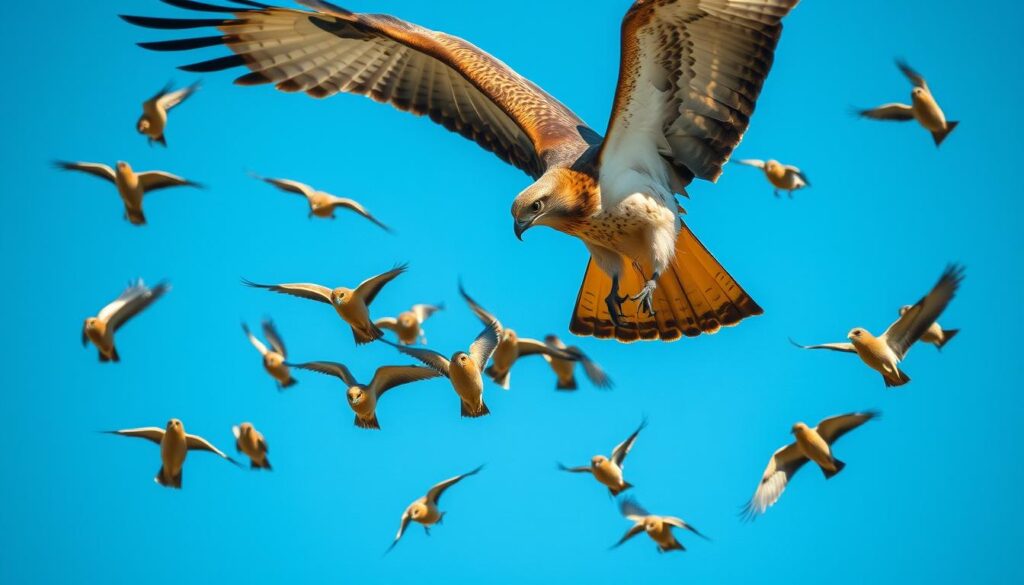
Urban vs. Natural Environment Mobbing
Bird mobbing is fascinating in both cities and nature. Birds in cities have changed how they mob to face human challenges. This shows how birds can adapt to new environments.
Adaptation to Human Environments
In cities, birds face many predators, including hawks and feral animals. They use smart mobbing to scare away these threats. This helps protect their homes and food sources.
Changes in Mobbing Patterns
Mobbing patterns change between cities and nature. Urban bird behavior is shaped by city life and the types of predators. Environmental adaptation is key in these different settings.
| Characteristic | Urban Environment | Natural Environment |
|---|---|---|
| Predator Diversity | Diverse, including human-introduced species | Predominantly natural predators |
| Mobbing Intensity | Potentially higher due to increased threat perception | May vary based on predator type and resource availability |
| Mobbing Coordination | Highly coordinated among urban bird species | May involve fewer species or less organized mobbing |
| Perch Availability | Limited, leading to more aerial mobbing | Abundant, allowing for both aerial and ground-based mobbing |
Studying urban bird behavior and environmental adaptation helps us understand mobbing patterns. It shows how birds can live well in many places.
The Evolution of Anti-Predator Strategies
Small birds chasing hawks is a key part of their defense against predators. This behavior is just one of many ways birds have learned to stay safe. It shows how birds and predators have a long history of trying to outsmart each other.
Birds have many ways to avoid predators, like looking like their surroundings or flying at night. These strategies help them stay hidden from predators. They also help birds avoid being seen by predators that are active during the day.
Whether a bird will mob a predator or fly away depends on several things. Smaller birds often mob, while bigger ones tend to fly away. Birds also choose their actions based on where they are. They are less likely to mob in open areas because they are more exposed.
| Anti-Predator Adaptation | Description | Examples |
|---|---|---|
| Camouflage | Blending into the environment to avoid detection | Flat-tailed horned lizard, potoo bird |
| Nocturnality | Being active at night to avoid diurnal predators | Fruit bats, kangaroo rats |
| Pursuit-Deterrent Signals | Convincing predators not to pursue prey | White-tailed deer fawns, marine mollusks |
| Mimicry | Simulating signal properties of another organism to confuse predators | Apostatic selection, thanatosis (playing dead) |
The fight between predators and prey is a constant battle. As predators get smarter, prey must find new ways to stay safe. This never-ending battle shows how adaptable and resilient birds and other animals are.

Conclusion
Mobbing behavior in birds, like small birds chasing hawks, is really interesting. It helps protect territories, young, and community members. This shows how birds defend themselves and each other.
Understanding mobbing helps us see how birds survive. It shows how they use hormones and communication to work together. Birds adapt well to threats, whether in cities or nature.
Studying bird mobbing behavior helps us appreciate birds more. It also shows why we need to protect them. By learning about bird behavior, we can live better with them and keep ecosystems balanced. Exploring bird behavior teaches us a lot about nature and encourages us to care for birds and their homes.
FAQ
What is mobbing behavior in birds?
Mobbing is when smaller birds attack larger birds or mammals. They do this to protect their homes, young, or nonbreeding areas. This defense helps smaller birds and their communities survive.
Why do small birds chase hawks?
Small birds chase hawks to keep their territories, nests, and young safe. This is a way to fight off bigger birds of prey. It helps protect them from being eaten.
What bird species are commonly involved in mobbing?
Birds like chickadees, titmice, kingbirds, blackbirds, grackles, jays, and crows mob often. They work together, even with different species, to scare away predators like hawks, crows, ravens, herons, and owls.
When is mobbing behavior most frequent?
Mobbing is most common in spring and early summer. This is when birds are most protective of their nests and young. But, it can happen all year, with more or less activity depending on the season.
How does mobbing behavior protect bird communities?
Mobbing is a team effort to keep birds safe. By chasing away predators, smaller birds make their homes safer. This also warns other birds of dangers, helping keep the whole community safe.
What is the role of communication in mobbing behavior?
Communication is key in mobbing. Birds use alarm calls to warn others and get help. These calls are similar across species, helping birds work together against predators.
How effective is mobbing in deterring hawks?
Mobbing can scare hawks away, making them leave the area. This can even force them to hunt elsewhere. How well mobbing works against hawks depends on how many birds are involved and how long they keep it up.
Are there any risks involved in mobbing behavior?
Mobbing might seem risky for smaller birds, but it’s usually safer than it looks. The birds’ quickness and surprise help them. Still, there are risks, and sometimes birds might get too close to the predator they’re chasing.
How does mobbing behavior differ between urban and natural environments?
Urban birds have adapted mobbing to face human challenges and different predators. Mobbing patterns vary between cities and nature due to different predators and environments.
How has the evolution of mobbing behavior influenced bird survival strategies?
Mobbing is part of birds’ long-term fight against predators. It shows how birds have adapted to survive. The evolution of mobbing highlights the ongoing battle between predators and prey.
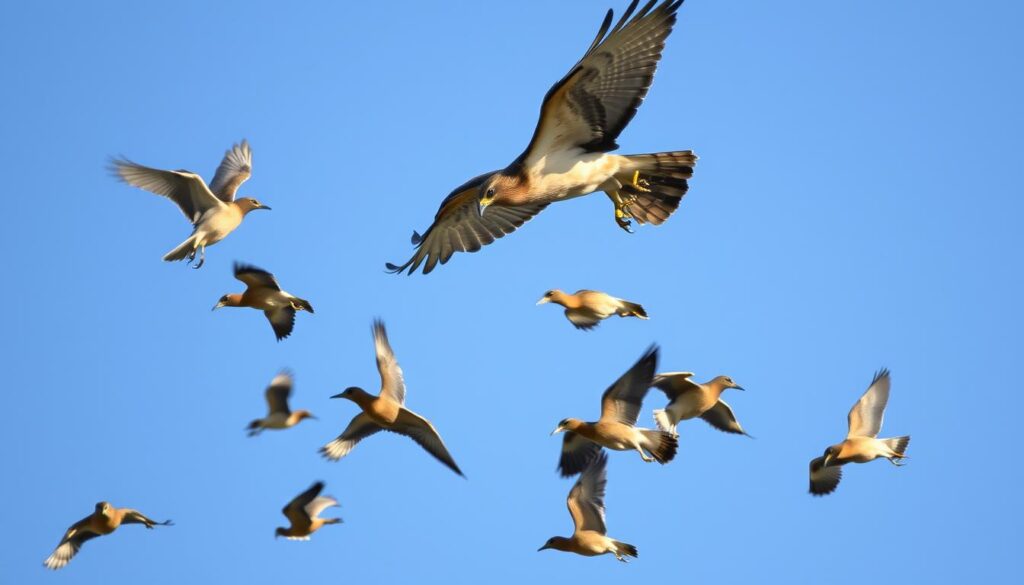

I am extremely impressed along with your writing talents as well as with the structure on your weblog.
Is that this a paid subject or did you modify it your self?
Anyway stay up the excellent quality writing, it’s rare to see a great weblog
like this one these days. Instagram Auto comment!
маркетплейс аккаунтов https://magazin-akkauntov-online.ru/
магазин аккаунтов социальных сетей магазин аккаунтов
услуги по продаже аккаунтов аккаунты с балансом
платформа для покупки аккаунтов маркетплейс аккаунтов соцсетей
Sell Pre-made Account Purchase Ready-Made Accounts
Gaming account marketplace Account Selling Service
Account Trading Service Account trading platform
Account market Secure Account Sales
Secure Account Sales Account Catalog
Website for Selling Accounts Account Purchase
Account exchange Sell Pre-made Account
Database of Accounts for Sale Accounts for Sale
Find Accounts for Sale Account Buying Platform
Online Account Store Account Selling Platform
account sale buy account
account trading platform account selling platform
account exchange service ready-made accounts for sale
profitable account sales account selling service
guaranteed accounts find accounts for sale
secure account sales buy and sell accounts
guaranteed accounts account marketplace
We stumbled over here by a different web address and
thought I might as well check things out. I like
what I see so now i am following you. Look forward to looking at your web page repeatedly.
My website … nordvpn coupons inspiresensation [http://tinylink.in/]
buy accounts buy and sell accounts
account market website for selling accounts
account trading platform ready-made accounts for sale
social media account marketplace online account store
account catalog secure account purchasing platform
find accounts for sale buy account
account store account sale
social media account marketplace account selling service
account exchange account market
buy pre-made account secure account purchasing platform
account market account catalog
online account store buy pre-made account
verified accounts for sale purchase ready-made accounts
sell accounts gaming account marketplace
account buying platform buy accounts
account market account exchange service
ready-made accounts for sale purchase ready-made accounts
account selling platform account selling platform
accounts marketplace social media account marketplace
gaming account marketplace accounts-offer.org
account selling service https://accounts-marketplace.xyz
account trading accounts market
secure account sales accounts market
sell accounts https://accounts-marketplace.live/
marketplace for ready-made accounts social-accounts-marketplace.xyz
account market https://buy-accounts.space
purchase ready-made accounts https://buy-accounts-shop.pro/
account market https://buy-accounts.live
ready-made accounts for sale account marketplace
account sale https://accounts-marketplace-best.pro
площадка для продажи аккаунтов akkaunty-na-prodazhu.pro
площадка для продажи аккаунтов https://rynok-akkauntov.top
купить аккаунт kupit-akkaunt.xyz
купить аккаунт akkaunt-magazin.online
площадка для продажи аккаунтов маркетплейсов аккаунтов
магазин аккаунтов купить аккаунт
продать аккаунт магазины аккаунтов
продажа аккаунтов https://online-akkaunty-magazin.xyz
маркетплейс аккаунтов https://akkaunty-dlya-prodazhi.pro
купить аккаунт https://kupit-akkaunt.online
buy facebook accounts https://buy-adsaccounts.work
buy fb ads account https://buy-ad-account.top
buy fb ad account https://buy-ads-account.click
buy facebook account https://ad-account-buy.top/
buy facebook ad accounts buy facebook profiles
buy fb ads account https://ad-account-for-sale.top
facebook ad account buy https://buy-ad-account.click
В этом информативном тексте представлены захватывающие события и факты, которые заставят вас задуматься. Мы обращаем внимание на важные моменты, которые часто остаются незамеченными, и предлагаем новые перспективы на привычные вещи. Подготовьтесь к тому, чтобы быть поглощенным увлекательными рассказами!
Исследовать вопрос подробнее – https://medalkoblog.ru/
buy facebook ads manager buy facebook account
buy verified google ads account buy google ads accounts
buy google agency account https://buy-ads-accounts.click
facebook ad account buy buy-accounts.click
buy adwords account https://ads-account-for-sale.top
buy adwords account buy google ad account
buy verified google ads account https://buy-ads-invoice-account.top
buy google ads https://buy-account-ads.work
buy old google ads account https://buy-ads-agency-account.top
google ads reseller https://sell-ads-account.click/